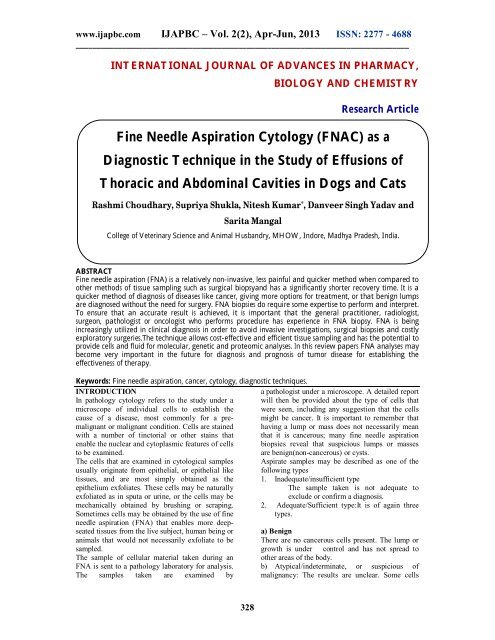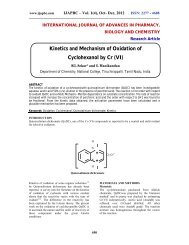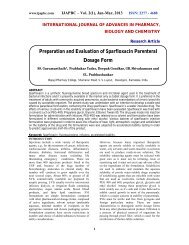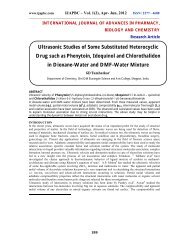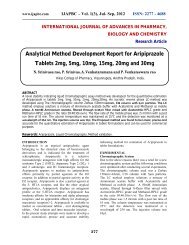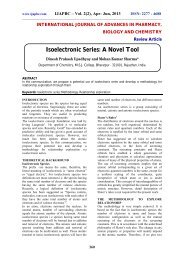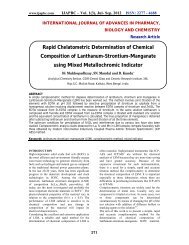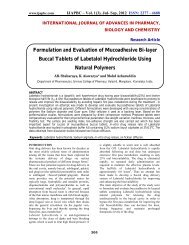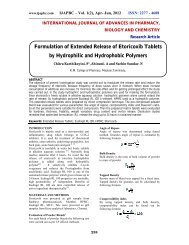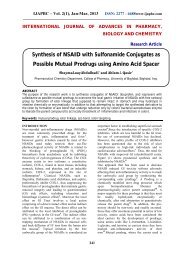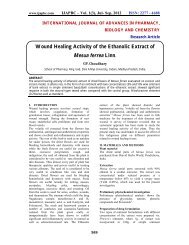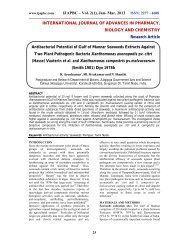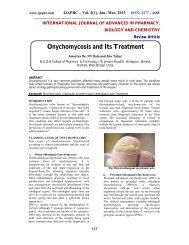Fine Needle Aspiration Cytology (FNAC) as a Diagnostic ... - ijapbc
Fine Needle Aspiration Cytology (FNAC) as a Diagnostic ... - ijapbc
Fine Needle Aspiration Cytology (FNAC) as a Diagnostic ... - ijapbc
Create successful ePaper yourself
Turn your PDF publications into a flip-book with our unique Google optimized e-Paper software.
www.<strong>ijapbc</strong>.com IJAPBC – Vol. 2(2), Apr-Jun, 2013 ISSN: 2277 - 4688<br />
________________________________________________________________________________<br />
INTERNATIONAL JOURNAL OF ADVANCES IN PHARMACY,<br />
BIOLOGY AND CHEMISTRY<br />
Research Article<br />
<strong>Fine</strong> <strong>Needle</strong> <strong>Aspiration</strong> <strong>Cytology</strong> (<strong>FNAC</strong>) <strong>as</strong> a<br />
<strong>Diagnostic</strong> Technique in the Study of Effusions of<br />
Thoracic and Abdominal Cavities in Dogs and Cats<br />
R<strong>as</strong>hmi Choudhary, Supriya Shukla, Nitesh Kumar * , Danveer Singh Yadav and<br />
Sarita Mangal<br />
College of Veterinary Science and Animal Husbandry, MHOW, Indore, Madhya Pradesh, India.<br />
ABSTRACT<br />
<strong>Fine</strong> needle <strong>as</strong>piration (FNA) is a relatively non-inv<strong>as</strong>ive, less painful and quicker method when compared to<br />
other methods of tissue sampling such <strong>as</strong> surgical biopsyand h<strong>as</strong> a significantly shorter recovery time. It is a<br />
quicker method of diagnosis of dise<strong>as</strong>es like cancer, giving more options for treatment, or that benign lumps<br />
are diagnosed without the need for surgery. FNA biopsies do require some expertise to perform and interpret.<br />
To ensure that an accurate result is achieved, it is important that the general practitioner, radiologist,<br />
surgeon, pathologist or oncologist who performs procedure h<strong>as</strong> experience in FNA biopsy. FNA is being<br />
incre<strong>as</strong>ingly utilized in clinical diagnosis in order to avoid inv<strong>as</strong>ive investigations, surgical biopsies and costly<br />
exploratory surgeries.The technique allows cost-effective and efficient tissue sampling and h<strong>as</strong> the potential to<br />
provide cells and fluid for molecular, genetic and proteomic analyses. In this review papers FNA analyses may<br />
become very important in the future for diagnosis and prognosis of tumor dise<strong>as</strong>e for establishing the<br />
effectiveness of therapy.<br />
Keywords: <strong>Fine</strong> needle <strong>as</strong>piration, cancer, cytology, diagnostic techniques.<br />
INTRODUCTION<br />
In pathology cytology refers to the study under a<br />
microscope of individual cells to establish the<br />
cause of a dise<strong>as</strong>e, most commonly for a premalignant<br />
or malignant condition. Cells are stained<br />
with a number of tinctorial or other stains that<br />
enable the nuclear and cytopl<strong>as</strong>mic features of cells<br />
to be examined.<br />
The cells that are examined in cytological samples<br />
usually originate from epithelial, or epithelial like<br />
tissues, and are most simply obtained <strong>as</strong> the<br />
epithelium exfoliates. These cells may be naturally<br />
exfoliated <strong>as</strong> in sputa or urine, or the cells may be<br />
mechanically obtained by brushing or scraping.<br />
Sometimes cells may be obtained by the use of fine<br />
needle <strong>as</strong>piration (FNA) that enables more deepseated<br />
tissues from the live subject, human being or a) Benign<br />
animals that would not necessarily exfoliate to be<br />
sampled.<br />
growth is under<br />
The sample of cellular material taken during an<br />
FNA is sent to a pathology laboratory for analysis.<br />
The samples taken are examined by<br />
a pathologist under a microscope. A detailed report<br />
will then be provided about the type of cells that<br />
were seen, including any suggestion that the cells<br />
might be cancer. It is important to remember that<br />
having a lump or m<strong>as</strong>s does not necessarily mean<br />
that it is cancerous; many fine needle <strong>as</strong>piration<br />
biopsies reveal that suspicious lumps or m<strong>as</strong>ses<br />
are benign(non-cancerous) or cysts.<br />
Aspirate samples may be described <strong>as</strong> one of the<br />
following types<br />
1. Inadequate/insufficient type<br />
The sample taken is not adequate to<br />
exclude or confirm a diagnosis.<br />
2. Adequate/Sufficient type:It is of again three<br />
types.<br />
There are no cancerous cells present. The lump or<br />
control and h<strong>as</strong> not spread to<br />
other are<strong>as</strong> of the body.<br />
b) Atypical/indeterminate, or suspicious of<br />
malignancy: The results are unclear. Some cells<br />
328
www.<strong>ijapbc</strong>.com IJAPBC – Vol. 2(2), Apr-Jun, 2013 ISSN: 2277 - 4688<br />
________________________________________________________________________________<br />
appear abnormal but are not definitely cancerous.<br />
A surgical biopsy may be required to adequately<br />
sample the cells.<br />
c) Malignant<br />
The cells are cancerous, uncontrolled and have the<br />
potential or have spread to other are<strong>as</strong> of the body.<br />
<strong>Fine</strong>-needle <strong>as</strong>piration (FNA) is a biopsy technique<br />
that uses <strong>as</strong>piration to obtain cells or fluid from<br />
palpable or ultra sound-detected m<strong>as</strong>ses i.e. the<br />
technique is applied for diagnosis of palpable <strong>as</strong><br />
well <strong>as</strong> non-palpable lesions.<br />
Palpable M<strong>as</strong>s Lesions includes lymph nodes,<br />
mammary gland, thyroid, salivary glands, soft<br />
tissue m<strong>as</strong>ses, bones Non-palpable M<strong>as</strong>s Lesions<br />
includes Abdominal cavity, thoracic cavity and<br />
retroperitoneum Non-palpable lesions require some<br />
form of localization by radiological aids for FNA<br />
to be carried out. Plain x-ray is usually adequate for<br />
lesions in bones and chest. Ultr<strong>as</strong>onography (USG)<br />
allows direct visualization of needle in intraabdominal<br />
and soft tissue m<strong>as</strong>ses. CT scan can be<br />
used for lesions in chest and abdomen.<br />
Effusions are small amount of fluid present in the<br />
body cavities in different dise<strong>as</strong>e conditions. In this<br />
topic we mainly focus on <strong>FNAC</strong> in the study of<br />
effusions of thoracic and abdominal cavities in<br />
dogs and cats.<br />
History<br />
The first report on the use of needles for<br />
therapeutic purposes can be found in Arab<br />
medicine, in the writings of Albuc<strong>as</strong>is or Abu al-<br />
Q<strong>as</strong>im, court physician (936-1013A.D) in medieval<br />
period. He first time described the therapeutic<br />
punctures of the thyroid gland, using instruments<br />
resembling modern <strong>as</strong>piration needles.<br />
Albuc<strong>as</strong>is' description resembles a modern FNA of<br />
the thyroid gland (Kaadan, 2004).The earliest<br />
report of a needle technique to obtain material for<br />
microscopy w<strong>as</strong> employed by Kun in 1847 who<br />
described a “new instrument for the diagnosis of<br />
tumors”. There followed sporadic reports of this<br />
technique, by clinicians including Leydon who in<br />
1883 used needle <strong>as</strong>piration to obtain cells to<br />
isolate pneumonic microorganisms and Greig and<br />
Gray in 1904 diagnosed trypanosomi<strong>as</strong>is in<br />
cervical lymph node <strong>as</strong>pirates from patients with<br />
sleeping sickness in Uganda (webb, 2003).<br />
Hayes Martin, Edward Ellis and Fred Stewart<br />
gave brief rebirth to this technique in 1930’s. In<br />
the early 20th century, Martin and Ellis are<br />
considered to be the founder of modern needle<br />
<strong>as</strong>piration techniques. After 20 th century <strong>FNAC</strong> h<strong>as</strong><br />
emerged <strong>as</strong> a sophisticated diagnostic technique<br />
both in the field of medical and veterinary science.<br />
Procedure for <strong>Fine</strong> <strong>Needle</strong> <strong>Aspiration</strong> <strong>Cytology</strong><br />
Materials required : <strong>Needle</strong> (22-25 guage),<br />
disposable syringe (3 - 20 ml), new gl<strong>as</strong>s slides,<br />
spirit swab, and suitable fixative is required.<br />
Preparation of the site for <strong>as</strong>piration<br />
If microbiological tests are to be performed on a<br />
portion of sample collected, or a body cavity is to<br />
be penetrated, the area of <strong>as</strong>piration is surgically<br />
prepared. An alcohol swab can be used to clean the<br />
area. If the samples are being collected using<br />
ultr<strong>as</strong>ound guidance, it is important to avoid the use<br />
of ultr<strong>as</strong>ound gel, substituting alcohol <strong>as</strong> a contact<br />
agent instead. Ultr<strong>as</strong>ound gel stains pink with<br />
commonly used cytology stains. Even a small<br />
amount of ultr<strong>as</strong>ound gel picked up <strong>as</strong> a<br />
contaminant when the needle p<strong>as</strong>ses through the<br />
skin and render a slide nondiagnostic.<br />
Procedure<br />
To restrain and to avoid unwanted<br />
movements during procedure the<br />
tranquliser (siquil @ 2 to 4 mg/ kg, IM<br />
route) will be given 10 min. prior to the<br />
procedure.<br />
Palpate the target area, if it is palpable<br />
m<strong>as</strong>s.<br />
Insert 22-25 guage needle into syringe<br />
depending upon suspected upon<br />
the suspected viscousness of sample<br />
material.<br />
Fix the m<strong>as</strong>s by palpating hand and insert<br />
needle into target area. Apply suction<br />
while moving needle back and forth<br />
within the lesions and change the direction<br />
of the needle.<br />
-<br />
- Terminate the <strong>as</strong>piration when <strong>as</strong>pirated<br />
material or blood is visible at the hub or<br />
b<strong>as</strong>e of the needle.<br />
- The negative pressure created within the<br />
syringe by <strong>as</strong>piration holds the tissue<br />
against the sharp cutting edge of the<br />
needle so that tissue will be cut by the<br />
329
www.<strong>ijapbc</strong>.com IJAPBC – Vol. 2(2), Apr-Jun, 2013 ISSN: 2277 - 4688<br />
________________________________________________________________________________<br />
cutting end of needle and accumulates<br />
within the lumen of the needle/ syringe<br />
- Rele<strong>as</strong>e the suction before withdrawing<br />
the needle to equalize pressure within the<br />
syringe.<br />
(PAS) stain, Alcian blue stain and<br />
Papanicolaou stain.<br />
3. 1.5% glutaraldehyde fixative solution is<br />
used for electronmicroscopic (EM) study.<br />
4. Specialized techniques are applied on<br />
immunohistochemistry for cancer<br />
markers.<br />
<br />
<br />
After withdrawal of needle apply pressure<br />
for 2-3 min. at the site of puncture to<br />
arrest bleeding and prevent hematoma<br />
formation.<br />
Aspirated material from the needle is<br />
expelled on to clean gl<strong>as</strong>s slide by<br />
detaching the needle and filling the<br />
syringe with air and expelling it with<br />
pressure.<br />
Collection tips<br />
1. Make and submit multiple slides<br />
This is one of the most important thing that can be<br />
done to incre<strong>as</strong>e the diagnostic yield. Small gauge<br />
needle are used for collecting cytological<br />
specimens and prepare multiple slides. If possible,<br />
a minimum of four to five slides, from several sites<br />
within the lesion should be submitted from any<br />
lesion. If multiple m<strong>as</strong>ses are sampled, always use<br />
a new needle and syringe with each m<strong>as</strong>s to avoid<br />
contamination from previous collection attempts.<br />
There are many re<strong>as</strong>ons why anyone slide may be<br />
nondiagnostic.<br />
a) The needle missed the lesion during<br />
collection (geographic miss).<br />
b) The needle is not in the area containing<br />
representative tissue of the lesion during<br />
sample collection. This is common in<br />
obese animals where the lesion may be<br />
surrounded by abundant subcut fat.<br />
c) If cells are ruptured during smear<br />
preparation.<br />
d) If slide prepared is too thick to evaluate.<br />
1. Avoid blood dilution<br />
Hemodilution is another common cause of<br />
nondiagnostic slides. The two major causes of<br />
blood contamination are the use of too large needle<br />
(
www.<strong>ijapbc</strong>.com IJAPBC – Vol. 2(2), Apr-Jun, 2013 ISSN: 2277 - 4688<br />
________________________________________________________________________________<br />
Cells and structures seen in effusions<br />
Neutrophils<br />
Neutrophils are present to some degree in most<br />
effusions and tend to predominate in effusions<br />
<strong>as</strong>sociated with inflammation. Cytologically ,there<br />
are two types of neutrophils: degenerate and<br />
nondegenerate. (a) Degenerate neutrophils are<br />
neutrophils that have undergone hydropic<br />
degeneration. This is a morphological change that<br />
occurs in tissue or effusions because bacterial<br />
toxins alter cell membrane permeability. This<br />
allows water to diffuse into the cell and through the<br />
nuclear pores, causing the nucleus to swell, fill<br />
more of the cytopl<strong>as</strong>m, and stain homogeneously<br />
eosinophilic. This swollen, loose, homogenous<br />
eosinophilic nuclear chromatin pattern<br />
characterizes the degenerate neutrophils. (b)<br />
Nondegenerate neutrophils are neutrophils that<br />
have tightly clumped, hypersegmented, b<strong>as</strong>ophilic<br />
nuclear chromatin. These aged neutrophils are<br />
often seen phagocytized by macrophages<br />
(cytophagia). The presence of nondegenerate<br />
neutrophils suggests that the fluid is not septic,<br />
however bacteria that are not strong toxin<br />
producers, such <strong>as</strong> Actinomyces spp., may be<br />
<strong>as</strong>sociated with nondegenerate neutrophils.<br />
Mesothelial / Macrophage – Type Cells<br />
Mesothelial cells line the pleural, peritoneal, and<br />
pericardial cavities <strong>as</strong> well <strong>as</strong> visceral surfaces and<br />
are present in variable numbers in most effusions.<br />
They are large cells that may be present singly or in<br />
clusters. They generally contain a single round to<br />
oval nucleus but may be multinucleated. Their<br />
cytopl<strong>as</strong>m is slightly b<strong>as</strong>ophilic and may contain<br />
phagocytic debris, because activated mesothelial<br />
cells may become phagocytic.<br />
331
www.<strong>ijapbc</strong>.com IJAPBC – Vol. 2(2), Apr-Jun, 2013 ISSN: 2277 - 4688<br />
________________________________________________________________________________<br />
Lymphocytes<br />
Lymphocytes are present in many effusions and<br />
may be the predominant cell type in chylous and<br />
lymphomatous effusions and sometimes in<br />
inflammatory effusions.<br />
1. Chylous effusions primarily consist of<br />
small lymphocytes containing small<br />
amount of clear to blue cytopl<strong>as</strong>m, an oval<br />
to bean shaped nucleus, clumpy nuclear<br />
chromatin and no visible nucleoli. These<br />
cells are typically smaller than<br />
neutrophils.<br />
2. Lymphomatous effusions primarily<br />
consist of lymphobl<strong>as</strong>ts.Lymphobl<strong>as</strong>ts are<br />
immature lymphocytes. They contain a<br />
light blue nucleolus which may be<br />
surrounded by a ring of chromatin. There<br />
are small vacuoles in the<br />
cytopl<strong>as</strong>m. These cells are not found in<br />
normal circulating blood and should be<br />
recorded if found in a differential smear.<br />
Eosinophils<br />
Eosinophils may be present in effusions and are<br />
readily recognized by their rod- shaped, (in cats) or<br />
variably sized round (in dogs), orange granules.<br />
M<strong>as</strong>t cells<br />
M<strong>as</strong>t cells are readily identified by their purple<br />
granules. M<strong>as</strong>t cell tumors within body cavities<br />
may be <strong>as</strong>sociated with effusions and frequently<br />
exfoliate large numbers of m<strong>as</strong>t cells into the<br />
effusion.<br />
3. Reactive lymphocytes may be seen in<br />
inflammatory effusions. Reactive<br />
lymphocytes are also called pl<strong>as</strong>ma cells,<br />
are large lymphocytes with an egg shaped<br />
nucleus tending to locate at one end of the<br />
cells. They are about the same size <strong>as</strong><br />
monocytes. The cytopl<strong>as</strong>m of a reactive<br />
lymphocyte stains a deeper blue and the<br />
chromatin is clumpedand may appear <strong>as</strong><br />
spokes of a wheel. These cells are<br />
produced in response to an antigenic<br />
stimulus.<br />
Neopl<strong>as</strong>tic cells<br />
Neopl<strong>as</strong>tic cells may be observed in effusions with<br />
many different types of neopl<strong>as</strong>ia. Identification of<br />
the neopl<strong>as</strong>tic cells depends upon the viewers<br />
ability to recognize the cell type and signs of<br />
malignancy. <strong>Fine</strong> needle <strong>as</strong>pirate of lymph node<br />
from dog with multicentric lymphoma. <strong>Cytology</strong><br />
reveals a population of large, neopl<strong>as</strong>tic<br />
lymphobl<strong>as</strong>ts.<br />
332
www.<strong>ijapbc</strong>.com IJAPBC – Vol. 2(2), Apr-Jun, 2013 ISSN: 2277 - 4688<br />
________________________________________________________________________________<br />
Cl<strong>as</strong>sification of effusions in dogs and cats<br />
Total protein<br />
Cells per<br />
milliliter<br />
Cell types Special features<br />
1. Transudate 3000 Neutrophils Neutrophils Nondegenerate<br />
4. Septic exudate >3.0 g/dl >3000 Neutrophils Degenerate neutrophils<br />
5.Hemorrhagic >3.0 g/dl Variable<br />
Erythrophagia or<br />
Similar to<br />
hemosiderin in<br />
blood<br />
macrophages<br />
6. Neopl<strong>as</strong>tic >2.5 g/dl Variable Tumor cells<br />
Neopl<strong>as</strong>tic cell<br />
population identified<br />
Transudates<br />
Pure transudates most frequently form <strong>as</strong> a result of<br />
hypoproteinemia from either incre<strong>as</strong>ed loss or<br />
decre<strong>as</strong>ed production of albumin (Forrester et al.,<br />
1988). Albumin maintains the pl<strong>as</strong>ma colloidal<br />
osmotic pressure within the v<strong>as</strong>cular system,<br />
preventing leakage of fluid into and promoting<br />
reabsorption of fluid from the extrav<strong>as</strong>cular<br />
compartments, such <strong>as</strong> the body cavities.<br />
Transudates resulting from hypoalbuminemia alone<br />
usually require pl<strong>as</strong>ma albumin concentrations to<br />
be less than or equal to 1.0 g/dl . If hypertension is<br />
also present, however, <strong>as</strong> is sometimes seen<br />
<strong>as</strong>sociated with liver dise<strong>as</strong>es transudates may<br />
accumulate when albumin concentrations are<br />
greater than 1.0 g/dl (Cowell et al.,1989).<br />
Clinical conditions that result in pure transudate<br />
formation<br />
Dog with Ascites (fluid accumulation in<br />
abdomen)<br />
Modified transudates<br />
Occur <strong>as</strong> a result of fluid leakage from lymphatics<br />
carrying high protein lymph or blood vessels. Such<br />
leakage is caused by incre<strong>as</strong>es in hydrostatic<br />
pressure or permeability. Both of these conditions<br />
allow high protein ultrafiltrate fluid to p<strong>as</strong>s in to the<br />
cavity. Neither of these conditions results in<br />
chemotactants in the cavity ; therefore large<br />
numbers of inflammatory cells do not migrate into<br />
the fluid. Hence, high-protien (2.5–5.0 g/dl) ,low to<br />
333
www.<strong>ijapbc</strong>.com IJAPBC – Vol. 2(2), Apr-Jun, 2013 ISSN: 2277 - 4688<br />
________________________________________________________________________________<br />
moderate cellularity (1000–8000 cells/ml) fluid<br />
develops. The TNCC of the modified transudate<br />
overlaps that of the transudate. Modified<br />
transudates vary in color from amber to white to<br />
red and are frequently slightly turbid to turbid.<br />
Nondegenerate<br />
neutrophils,<br />
mesothelial/macrophage cell types, small<br />
lymphocytes, or neopl<strong>as</strong>tic cells may predominate,<br />
depending on the cause of the effusion. In general,<br />
they are caused by conditions that produce an<br />
incre<strong>as</strong>e in v<strong>as</strong>cular hydrostatic pressure or<br />
permeability within capillaries or lymphatics.<br />
Conditions resulting in modified transudates<br />
include congestive heart failure, lung atelect<strong>as</strong>is,<br />
diaphragmatic hernia, acute organ torsion, partial<br />
or complete obstruction to the cranial vena cava<br />
(thoracic effusion), caudal vena cava (abdominal<br />
effusion), or any dise<strong>as</strong>e resulting in intrahepatic<br />
portal hypertension.<br />
Exudates<br />
Exudates are the result of leakage of fluid from<br />
abnormal or altered v<strong>as</strong>culature. This generally<br />
occurs because of an inflammatory process or<br />
chemotactic stimuli within the body cavity . The<br />
inflammatory process incre<strong>as</strong>es serosal and<br />
v<strong>as</strong>cular permeability, resulting in a fluid with<br />
elevated protein and often a high TNCC. Exudates<br />
are further cl<strong>as</strong>sified <strong>as</strong> septic or nonseptic<br />
depending on whether or not infectious agents are<br />
identified in the fluid. Cl<strong>as</strong>sification <strong>as</strong> a septic<br />
exudate would indicate that microorganisms have<br />
been identified microscopically or by culture<br />
techniques. Nonseptic exudates result from<br />
noninfectious causes of inflammation in the body<br />
cavity, including conditions that cause longstanding<br />
modified transudates. Exudates may vary<br />
in color from white to amber to pink, but they are<br />
usually turbid. The protein content is usually high<br />
(>3 g/dL), and the cell counts are typically higher<br />
than 3000 cells per milliliter. The exception to this<br />
is uroperitoneum, which h<strong>as</strong> a low cell count and<br />
protein because of the accumulation of urine in the<br />
body cavity. The numeric parameters of exudates<br />
overlap with those of modified transudates;<br />
however, in exudates, the neutrophil is generally<br />
the predominant cell population, indicating the<br />
presence of inflammation. The neutrophils are<br />
often accompanied by variable numbers of other<br />
inflammatory cells, including macrophages,<br />
lymphocytes, eosinophils, and mesothelial cells.<br />
The morphologic appearance of the neutrophils<br />
may give an indication <strong>as</strong> to whether the exudate is<br />
septic or not. Specific degenerative changes in<br />
neutrophils suggest the presence of sepsis.<br />
Degenerative changes are nuclear changes that<br />
indicate cell death. Some degenerative changes,<br />
such <strong>as</strong> pyknosis, are the result of slow cell death in<br />
a relatively nontoxic environment . Pyknotic cells<br />
are more typically observed in nonseptic exudates,<br />
and pyknosis alone should not alert the clinician to<br />
the presence of sepsis. Karyolysis and karyorrhexis<br />
are degenerative changes that indicate a more rapid<br />
cell death in a more toxic environment . Karyolytic<br />
cells have a pale swollen nucleus similar to the<br />
appearance of cells lysed during sample<br />
preparation. Cells lysed during sample preparation<br />
have a lysed cytopl<strong>as</strong>mic membrane, however,<br />
unlike karyolytic cells, where the cytopl<strong>as</strong>mic<br />
membrane is still intact. The presence of karyolysis<br />
and karyorrhexis warrants strong consideration of<br />
sepsis, a thorough examination of the fluid for the<br />
presence of intracellular or extracellular<br />
microorganisms, and microbial culture .Although<br />
most exudates contain a predominant population of<br />
neutrophils, some inflammatory fluids may, in<br />
addition to neutrophils, contain a significant (10%)<br />
eosinophil component. These exudates may be<br />
specifically termed eosinophilic effusions .<br />
Eosinophilic effusions are infrequently seen in<br />
veterinary medicine. In one study, approximately<br />
half of these effusions were <strong>as</strong>sociated with<br />
neopl<strong>as</strong>ms, including lymphoma, systemic<br />
m<strong>as</strong>tocytosis,and hemangiosarcoma (HSA). Other<br />
causes of eosinophilic effusions include allergic<br />
hypersensitivity conditions, par<strong>as</strong>itic dise<strong>as</strong>es (eg,<br />
heartworm dise<strong>as</strong>e, intestinal par<strong>as</strong>ites),<br />
pneumothorax, lung lobe torsion, intestinal<br />
lymphangiect<strong>as</strong>ia, and lymphomatoid<br />
granulomatosis.<br />
Nonseptic exudates<br />
A number of clinical conditions, such <strong>as</strong> feline<br />
infectious peritonitis (FIP), foreign objects or<br />
material in the body cavity, pancreatitis, steatitis,<br />
bile or urine leakage, neopl<strong>as</strong>ms, torsion of internal<br />
organs (eg, lung lobes, liver lobes, spleen),<br />
inflamed internal organs, or walled-off abscesses,<br />
may result in a nonseptic exudate.. Other nonseptic<br />
exudates have general features of elevated protein<br />
and TNCC with a predominant population<br />
ofnondegenerate neutrophils with lower numbers of<br />
hypersegmented neutrophils and pyknotic cells.<br />
Specific conditions resulting in nonseptic exudates<br />
include the following.<br />
Uroperitoneum, Bile peritonitis, Feline infectious<br />
peritonitis (FIP.<br />
Septic exudates<br />
The identification of phagocytized intracellular<br />
organisms, usually bacteria, distinguishes a septic<br />
exudate from a nonseptic one. The absence of<br />
microscopically identifiable bacteria does not<br />
always rule out sepsis, however, and further<br />
investigation, such <strong>as</strong> culture, may be warranted<br />
when exudates are identified, particularly if<br />
degenerative changes are seen in the neutrophils.<br />
The predominant cell type in most septic exudates<br />
is the neutrophil. Many of these cells are<br />
degenerate <strong>as</strong> evidenced by nuclear karyolysis<br />
334
www.<strong>ijapbc</strong>.com IJAPBC – Vol. 2(2), Apr-Jun, 2013 ISSN: 2277 - 4688<br />
________________________________________________________________________________<br />
(swollen pale nucleus) or karyorrhexis (nuclear<br />
fragmentation). Karyolytic neutrophils in an<br />
effusion warrant suspicion of sepsis, but definitive<br />
identification relies on the presence of intracellular<br />
organism. Extracellular bacteria may also be<br />
observed, but care must be taken to ensure that<br />
these organisms are not contaminants, normal flora,<br />
or present in used staining solutions. Numerous<br />
bacterial types have been <strong>as</strong>sociated with septic<br />
exudates in the dog and cat. Most septic exudates,<br />
particularly in the cat, involve anaerobes or<br />
facultative anaerobe. In general, identification of<br />
bacterial species and appropriate microbial therapy<br />
should be determined by culture techniques. The<br />
exception may be Actinomyces and Nocardia,<br />
which appear microscopically <strong>as</strong> characteristic<br />
long, filamentous, beaded rods along with the<br />
presence of ‘‘sulfur granules,’’ which are<br />
microcolonies of bacteria .Many septic exudates<br />
occur by introducing organisms into the body<br />
cavity via traumatic puncture wounds; bite wounds;<br />
perforation of the intestinal tract; migrating foreign<br />
bodies; ruptured pulmonary, hepatic, or prostatic<br />
abscesses; pyometra; pneumonia; or pleuritis. Most<br />
septic exudates involve bacterial sepsis; however,<br />
infections with Mycopl<strong>as</strong>ma, rickettsial agents,<br />
fungal agents, and par<strong>as</strong>ites may occur less<br />
frequently.<br />
Hemorrhagic effusions<br />
Hemorrhagic effusions can result from ruptured<br />
vessels or alterations in v<strong>as</strong>cular endothelial<br />
integrity that is normally maintained by the<br />
interaction of platelets and various clotting factors.<br />
Hemorrhagic effusions grossly and microscopically<br />
contain a certain amount of blood, and the PCV of<br />
the fluid should be at le<strong>as</strong>t 10% to 25% of the<br />
peripheral blood. These fluids must be<br />
distinguished from the iatrogenic blood<br />
contamination that might occur during any<br />
sampling procedure. Several factors may help in<br />
distinguishing between these two processes, but<br />
peracute hemorrhage occurring less than 45<br />
cinom<strong>as</strong>, adeno carcinom<strong>as</strong> and rarely sarcom<strong>as</strong><br />
have been diagnosed by cytologic evaluation of<br />
effusions.<br />
minutes after sampling may be impossible to<br />
distinguish from iatrogenic contamination. One<br />
distinguishing factor is that platelets are usually not<br />
seen in hemorrhagic effusions present for more<br />
than 1 hour before sampling. Similarly, because of<br />
the rapid mechanical defibrination that occurs after<br />
extravagation, blood that is the result of<br />
hemorrhage into a body cavity does not clot, even<br />
in a clot tube. Additionally, true hemorrhagic<br />
effusions eventually contain reactive macrophages<br />
with phagocytized erythrocytes or intracytopl<strong>as</strong>mic<br />
hemosiderin and/or hematoidin. Conversely,<br />
iatrogenic contamination with peripheral blood<br />
during sampling contains platelets and usually clots<br />
after collection. There are no specific numeric<br />
values that define a hemorrhagic effusion;<br />
however, hemorrhagic fluid with leukocyte counts<br />
significantly higher than that seen in the peripheral<br />
blood should be considered inflammatory <strong>as</strong> well.<br />
Neopl<strong>as</strong>tic effusions<br />
Neopl<strong>as</strong>ia is a common cause of effusions in dogs<br />
and cats. In one report, 57% of pericardial<br />
effusions and 11% of peritoneal and pleural<br />
effusions in the dog were the result of neopl<strong>as</strong>ia. In<br />
the same study, neopl<strong>as</strong>tic effusions accounted for<br />
37% of the pleural effusions in cats. Neopl<strong>as</strong>tic<br />
processes occurring within the body cavities may<br />
result in various types of fluid accumulations,<br />
including modified transudates, exudates, and<br />
hemorrhagic effusions. In one study involving<br />
more than 400 peritoneal and pleural effusions in<br />
dogs and cats, even in the hands of experienced<br />
cytopathologists, cytologic evaluation for the<br />
detection of tumors had a sensitivity of 64% and<br />
61% in dogs and cats, respectively (Hirschberger et<br />
al. 1999). Most effusions caused by tumors not<br />
exfoliating neopl<strong>as</strong>tic cells are in the modified<br />
transudate range. However, most effusions caused<br />
by tumors that are exfoliating cells into the cavity<br />
and are secondarily inflamed are in the exudates<br />
category. Lymphoma, m<strong>as</strong>t cell tumor,<br />
mesothelioma, and various car<br />
.<br />
Hemangiosarcoma in a dog<br />
335
www.<strong>ijapbc</strong>.com IJAPBC – Vol. 2(2), Apr-Jun, 2013 ISSN: 2277 - 4688<br />
________________________________________________________________________________<br />
M<strong>as</strong>t Cell Tumor (Neopl<strong>as</strong>ia)<br />
Complications of <strong>FNAC</strong><br />
Complications are few and seldom serious. The<br />
incidence of major complications reported is well<br />
below 1% and generally in the range of 0.05%<br />
(Frable,1989). Serious complications include:<br />
needle track seeding, pneumothorax in animals<br />
with axillary m<strong>as</strong>ses, transient acute swelling,<br />
hematom<strong>as</strong>, and histological alterations. More<br />
serious and sometimes life-threatening<br />
complications may occur with <strong>as</strong>piration of deep<br />
organs. In the chest, these include m<strong>as</strong>sive<br />
hemorrhage, air embolism, and tamponade. Risk<br />
factors to be considered that may influence the<br />
development of complications following FNA are<br />
patient’sage, presence of underlying dise<strong>as</strong>e, and<br />
bleeding disorders. Also exerting influence on the<br />
rate of complications are location, size, and the<br />
depth of the m<strong>as</strong>s; needle size; number of p<strong>as</strong>ses<br />
andlevel of experience of the <strong>as</strong>pirator.<br />
Benefits of <strong>FNAC</strong><br />
Cost effectiveness (simple and cheap)<br />
It h<strong>as</strong> lower risk than surgical biopsy.<br />
It is readily repeatable and useful for<br />
multifocal lesions.<br />
Minimal physical and psychological<br />
discomfort for the patient.<br />
Rapid reporting and bedside diagnosis of<br />
neopl<strong>as</strong>tic, hyperpl<strong>as</strong>tic, and inflammatory<br />
m<strong>as</strong>ses.<br />
Therapeutic procedure for the evacuation<br />
of cystic lesions.<br />
Permits the diagnosis of some benign<br />
conditions for which there is no need for<br />
surgery.<br />
It is a rapid means of confirmation of<br />
recurrence of previously treated<br />
malignancy without surgery (Varg<strong>as</strong> and<br />
M<strong>as</strong>ood, 2003).<br />
Limitations<br />
Sampling is scanty and histological<br />
architecture is lost thereby rendering<br />
impossible diagnosis b<strong>as</strong>ed on histology.<br />
336
www.<strong>ijapbc</strong>.com IJAPBC – Vol. 2(2), Apr-Jun, 2013 ISSN: 2277 - 4688<br />
________________________________________________________________________________<br />
<br />
<br />
<br />
<br />
Inflammatory, metapl<strong>as</strong>tic or degenerative<br />
lesions may mimic malignancy.<br />
Diagnosis is indefinite in some conditions<br />
such <strong>as</strong> follicular adenoma vs. carcinoma<br />
of the thyroid.<br />
Samples taken may not be representative<br />
of the lesion.<br />
Difficulty of cytological diagnosis in some<br />
conditions e.g. lymphom<strong>as</strong> (Orell,2003).<br />
CONCLUSIONS<br />
<strong>Fine</strong> needle <strong>as</strong>piration is a relatively non-inv<strong>as</strong>ive,<br />
less painful and quicker method when compared to<br />
other methods of tissue sampling such <strong>as</strong> surgical<br />
biopsyand h<strong>as</strong> a significantly shorter recovery time.<br />
It is a quicker method of diagnosis of dise<strong>as</strong>es like<br />
cancer, giving more options for treatment, or that<br />
benign lumps are diagnosed without the need for<br />
surgery.<br />
<strong>Fine</strong> needle <strong>as</strong>piration biopsies do require some<br />
expertise to perform and interpret. To ensure that<br />
an accurate result is achieved, it is important that<br />
the general practitioner, radiologist, surgeon,<br />
pathologist or oncologist who performs procedure<br />
h<strong>as</strong> experience in fine needle <strong>as</strong>piration biopsy.<br />
FNA is being incre<strong>as</strong>ingly utilized in clinical<br />
diagnosis in order to avoid inv<strong>as</strong>ive investigations,<br />
surgical biopsies and costly exploratory surgeries<br />
(Diamantis et al.,2009). The technique allows costeffective<br />
and efficient tissue sampling and h<strong>as</strong> the<br />
potential to provide cells and fluid for molecular,<br />
genetic and proteomic analyses. These analyses<br />
may become very important in the future for<br />
diagnosis and prognosis of tumor dise<strong>as</strong>e for<br />
establishing the effectiveness of therapy.<br />
6. Orell SR. Pitfalls in fine needle <strong>as</strong>piration<br />
cytology. Cytopathology. 2003;14:173-<br />
182.<br />
7. Varg<strong>as</strong> HI and M<strong>as</strong>ood S. Implementation<br />
of a minimally inv<strong>as</strong>ive bre<strong>as</strong>t biopsy<br />
program in countries with limited<br />
resources. Bre<strong>as</strong>t J.2003;9(2):81-85.<br />
8. Webb AJ. History of <strong>Fine</strong> <strong>Needle</strong><br />
<strong>Aspiration</strong> Livingstone. Philadelphia.<br />
2003;237-255.<br />
REFERENCES<br />
1. Cowell RL, Tyler RD and Meinkoth JH.<br />
Abdominal and Thoracic Fluid. In: Cowell<br />
RL, TylerRD (eds). <strong>Diagnostic</strong> cytology<br />
of the dog and cat. Goleta. Am Vet Publ.<br />
1989; 151–166.<br />
2. Diamantis A, Magiorkinis E and<br />
Koutselini H. <strong>Fine</strong>-needle <strong>as</strong>piration<br />
(FNA) biopsy: historical <strong>as</strong>pects, Folia<br />
Histochemica et Cytobiologica.<br />
2009;47(2):191-197.<br />
3. Forrester SD, Troy GC and Fossum TW.<br />
Pathophysiology and diagnostic<br />
considerations.Compend Contin Educ<br />
Pract Vet. 1988; 10:121–137.<br />
4. Frable WJ. <strong>Needle</strong> <strong>as</strong>piration biopsy: p<strong>as</strong>t,<br />
present and future.Hum. Patho. 1989;20:<br />
504-517.<br />
5. Hirschberger J, DeNicola DB, Hermanns<br />
W. Sensitivity and specificity of cytologic<br />
evaluation in the diagnosis of neopl<strong>as</strong>ia in<br />
body fluids from dogs and cats. Vet Clin<br />
Patho. 1999;28:142–146.<br />
337


